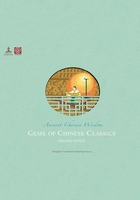
四民月令 (sì mín yuè lìng)
Ancient Guide Still Yields a Harvest
Monthly Instructions for Four Classes of People
Simin Yueling, or “Monthly Instructions for Four Classes of People,” is widely regarded as one of the oldest agricultural texts produced in China. Today, it is still deemed an important source for studies — not only of ancient Chinese agriculture, but also the Chinese social system, education, trade, medicine and health care of the time.
Most scholars believe the author was Cui Shi (103-170 AD), a scholar-bureaucrat from a family of landlords.
While a child, Cui loved reading books on a variety of topics. When an adult, he was first appointed by the imperial court as a local administrator and later as a consultant for the imperial court itself.
In Cui’s time, landowners controlled large estates which functioned as highly self-sufficient economic entities. Landowners not only recruited peasants to work in the fields but also in other activities on the estate. Peasants and craftsmen recruited by landowners were also organized into militias to defend the estate against robbers or bandits.
Cui’s monthly instructions were written for those landowners, so they could pick the most propitious time for various activities, and when to sell or purchase goods.
The title of the book indicates that Cui followed the prevailing practice of dividing people into four classes: scholar-bureaucrats; peasants; craftsmen; and traders.
Scholar-bureaucrats were part of the ruling class. Since only the sons of the rich or government officials had the opportunity to receive schooling, the term later came to be generally used to refer to male scholars.
Cui followed the writing style of “monthly instructions,” which were originally used to describe the rituals, functions and decrees that should be carried out by governments in each month of the year.

The contents of Cui’s book can roughly be divided into nine parts: 1. Family rituals, education and family relations; 2. Planting and reaping crops and vegetables according to the season; 3. Silkworm breeding, textiles, dyeing, tailoring and embroidery; 4. Processing foods and brewing; 5. Repairing houses and water conservation facilities; 6. Gathering wild fruit, plants and herbs; 7. Collecting and storing tools of all types after use; 8. Selling and purchasing products, such as grain, silk and silk products; and 9. Miscellaneous activities, such as promoting health care and sanitation.
Indeed, the author devoted less than half of the book to crop planting, processing foods, traditional Chinese medicine making and other productive activities designated for different months.
The remainder of the book focuses on descriptions of the rituals for ancestor worship, festival celebrations, the observation of religious holidays, codes of conduct of family members and prescribing auspicious seasons for schooling boys.
In addition, the book describes the practice of martial arts and guarding against burglars.
Unfortunately, Cui’s book was lost by the end of the Northern Song Dynasty (960-1127) and the editions existing today were recompiled by scholars in the following centuries, based on parts of the content quoted by other Chinese agricultural books and encyclopedias.
Many important contents of Cui’s book are preserved in Qimin Yaoshu, or “Essential Techniques for the Welfare of the People,” one of the greatest ancient Chinese agricultural texts, written in the Northern Wei Dynasty (386-534 AD).
Today, many scholars, both in and outside China, still turn to “Monthly Instructions for Four Classes of People” in order to obtain a better understanding of ancient Chinese agriculture, education, social system, trade, medicine and health care provisions.
As one of China’s oldest agricultural texts, the book was translated into German in 1963 and into Japanese in 1987.